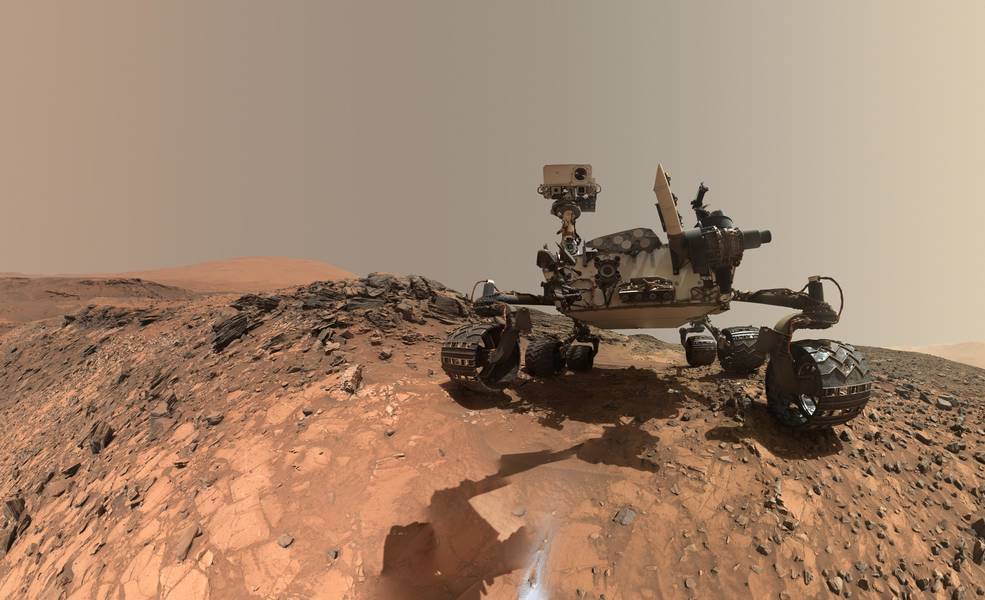Ever since
Curiosity
landed on Mars in 2012, the rover has made numerous groundbreaking discoveries about the Red Planet. These include confirming how Mars once had flowing water and
lakes on its surface
, evidence of how it
lost its ancient atmosphere
, and the discovery of
methane and organic molecules
. All of these discoveries have bolstered the theory that Mars may have once supported life.
The latest discovery came on Thursday, May 7th, when NASA announced that the
Curiosity
rover had once again discovered
organic molecules
. This time, however, the molecules were found in three-billion-year-old sedimentary rocks located near the surface of lower Mount Sharp. This evidence, along with new atmospheric evidence, are another indication that ancient life may have once existed on the Red Planet.
The new findings appear in two new studies - titled "
Organic matter preserved in 3-billion-year-old mudstones at Gale crater, Mars
" and "
Background levels of methane in Mars' atmosphere show strong seasonal variations
" - that were published in the June 8th issue of
Science.
As these studies indicate, these molecules - while not evidence of life in and of itself - have bolstered the search for evidence of past life.
[caption id="attachment_114501" align="aligncenter" width="580"]
MRO image of Gale Crater illustrating the landing location and trek of the Rover Curiosity since it landed in 2012. Credits: NASA/JPL, illustration, T.Reyes
[/caption]
As Thomas Zurbuchen, the associate administrator for the Science Mission Directorate at NASA Headquarters, explained in a recent NASA
press release
:
In the first paper, the authors indicate how
Curiosity's
Sample Analysis at Mars
(SAM) suite detected traces of methane in drill samples it took from Martian rocks. Once these rocks were heated, they released an array of organics and volatiles similar to how organic-rich sedimentary rocks do on Earth. On Earth, such deposits are indications of fossilized organic life, which may or may not be the case with the samples examined by
Curiosity.
However, this evidence is bolstered by the fact that Curiosity has also found evidence that the Gale Crater was once an ancient lakebed. In addition to water, this lakebed contained all the chemical building blocks and energy sources that are necessary for life. As Jen Eigenbrode of NASA's Goddard Space Flight Center, and the lead author of the first study,
explained
:
[caption id="attachment_131410" align="aligncenter" width="580"]
This image illustrates possible ways methane might get into Mars' atmosphere and also be removed from it. Credit: NASA/JPL-Caltech/SAM-GSFC/Univ. of Michigan
[/caption]
In the second paper, the team described how
Curiosity's
SAM suite also detected seasonal variations in methane in the Martian atmosphere. These results were obtained over the course of nearly three years on Mars, which works out to almost six Earth years. While the team admits that water-rock chemistry could have generated the methane, they cannot rule out the possibility that it was biological in origin.
In the past,
methane and organic molecules
have been detected in Mars' atmosphere and in drill samples, the former of which appeared to spike unpredictably. However, these new results indicate that within the Gale Crater, low levels of methane peak during the warm summer months and drop in the winter months every year. As Chris Webster, a researcher from NASA's Jet Propulsion Laboratory (JPL) and the lead author of the second paper,
explained
:
To find this organic material, Curiosity drilled into sedimentary rocks (known as mudstone) in four areas in the Gale Crater. These rocks formed over the course of billions of years as sediments were deposited at the bottom of the ancient lake by flowing water. The drill samples were then analyzed by SAM, which used its oven to heat the samples to over 500 °C (900 °F) to release organic molecules from the powdered rock.
[caption id="attachment_122799" align="aligncenter" width="580"]
Simulated view of Gale Crater Lake on Mars. This illustration depicts a lake of water partially filling Mars' Gale Crater, receiving runoff from snow melting on the crater's northern rim. Credit: NASA/JPL-Caltech/ESA/DLR/FU Berlin/MSSS
[/caption]
These results indicate that some of the drill samples contained sulfur (which could have preserved the organic molecules) as well as thiophenes, benzene, toluene, and small carbon chains - such as propane or butene. They also indicated organic carbon concentrations of about 10 parts per million or more, which is consistent with carbon concentrations observed in Martian meteorites and about 100 times what has been previously detected on Mars' surface.
While this does not constitute evidence of past life on Mars, these latest findings have increased confidence that future missions will find more organics, both on the surface and slightly beneath the surface. But above all, they have bolstered confidence that Mars may have once had life of its own. As Michael Meyer, the lead scientist for NASA's Mars Exploration Program, summarized:
In the coming years, additional missions will also be searching for signs of past life, including NASA's
*Mars 2020* rover
and the European Space Agency's
ExoMars rover
.
The
Mars 2020
rover will also leave samples behind in a cache that could be retrieved by a future crewed mission for sample-return analysis. So if there was life on Mars (or, fingers crossed, still is) we are sure to find it soon enough!
And be sure to check out this video of this latest discovery by
Curiosity
, courtesy of NASA's Jet Propulsion Laboratory:
Further Reading: NASA
 Universe Today
Universe Today
